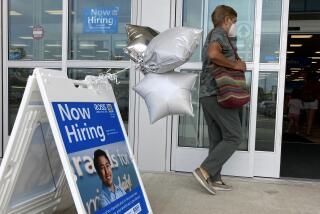Jobless Estimates Too Low, Bureau Says : Employment: Tests of a new survey method find that undercounting is especially bad among women. A question is changed to eliminate bias.
- Share via
WASHINGTON — The Bureau of Labor Statistics said Tuesday that the government has been substantially underestimating joblessness, particularly among women.
The underreporting was uncovered in tests of a new monthly survey technique that the department will begin using in January to measure unemployment.
In a report released Tuesday, the bureau said that in the year ending last August, the new survey produced an overall jobless rate of 7.6%, compared to the 7.1% rate that has been officially reported. The agency declined to release monthly figures from the new survey but said they ranged from 0.1 percentage point to 1 percentage point higher during the period.
The differences in the survey result because the new questionnaire solicits more accurate responses and removes a bias against measuring the number of women at work or seeking jobs, the agency said. More women were found to be working but also many more were unemployed. The unemployment rate for adult women averages 0.8 percentage points higher with the new survey.
On the other hand, the new method finds a smaller share of men who say they are working or looking for work, but their unemployment rate still averages 0.2 percentage points more.
The new survey, in which interviewers record responses on laptop computers that tailor the questions asked according to earlier answers, will replace the current official one-page pencil-and-paper version in January.
In addition to the higher unemployment rates, the new survey also shows significantly fewer people working part time who would prefer full-time work.
Katherine Abraham, commissioner of labor statistics, told reporters there are so many statistical uncertainties surrounding the switch in surveys that her agency will not know how to interpret the figures that the new survey generates in January.
That will be the first month in which a regular monthly sample of 60,000 households is questioned on the new basis. So far, the new approach has been used on a test basis to interview only 12,000 households in a separate sample.
“I would hope the financial markets would not pay any attention to the January numbers,” Abraham said. “I would ignore the February survey too.”
The most important differences between the old and new survey results stem from changing the first question asked to eliminate a gender bias and an age bias.
Currently, the way the first question is asked depends on the age and sex of the person who answers the door. If that person is a younger person of either sex, he or she is asked, “What were you doing most last week, going to school or something else?” An adult woman is asked, “What were you doing most last week, keeping house or something else?” Only for an adult man is the question worded, “What were you doing most last week, working or something else?”
Abraham said that, if she were asked the women’s version, “I would be offended.”
The new questionnaire starts by determining whether anyone in the household has a business or a farm, and then asks, “Last week, did you do any work for pay?” Or if there is a family business or farm, “. . . pay or profit?”
More to Read
Inside the business of entertainment
The Wide Shot brings you news, analysis and insights on everything from streaming wars to production — and what it all means for the future.
You may occasionally receive promotional content from the Los Angeles Times.










